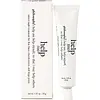What's inside
What's inside
 Key Ingredients
Key Ingredients

 Benefits
Benefits

 Concerns
Concerns

 Ingredients Side-by-side
Ingredients Side-by-side

Water
Skin ConditioningCaprylic/Capric Triglyceride
MaskingGlycerin
HumectantCetearyl Alcohol
EmollientC10-30 Cholesterol/Lanosterol Esters
EmulsifyingCetyl Alcohol
EmollientDimethicone
EmollientCetyl Ricinoleate
EmollientPolysorbate 60
EmulsifyingBenzyl Alcohol
PerfumingRetinol
Skin ConditioningTocopheryl Acetate
AntioxidantAscorbyl Palmitate
AntioxidantMethyl Methacrylate/Glycol Dimethacrylate Crosspolymer
Stearic Acid
CleansingPEG-10 Soy Sterol
EmulsifyingPhenoxyethanol
PreservativeCyclopentasiloxane
EmollientMagnesium Aluminum Silicate
AbsorbentCyclohexasiloxane
EmollientMethylparaben
PreservativeTriethanolamine
BufferingDisodium EDTA
Bisabolol
MaskingBHT
AntioxidantPolysorbate 20
EmulsifyingPropyl Gallate
AntioxidantAscorbic Acid
AntioxidantWater, Caprylic/Capric Triglyceride, Glycerin, Cetearyl Alcohol, C10-30 Cholesterol/Lanosterol Esters, Cetyl Alcohol, Dimethicone, Cetyl Ricinoleate, Polysorbate 60, Benzyl Alcohol, Retinol, Tocopheryl Acetate, Ascorbyl Palmitate, Methyl Methacrylate/Glycol Dimethacrylate Crosspolymer, Stearic Acid, PEG-10 Soy Sterol, Phenoxyethanol, Cyclopentasiloxane, Magnesium Aluminum Silicate, Cyclohexasiloxane, Methylparaben, Triethanolamine, Disodium EDTA, Bisabolol, BHT, Polysorbate 20, Propyl Gallate, Ascorbic Acid
Water
Skin ConditioningDimethicone
EmollientIsodecyl Neopentanoate
EmollientIsononyl Isononanoate
EmollientPropanediol
SolventCetearyl Alcohol
EmollientCaprylyl Methicone
Skin ConditioningCetyl Alcohol
EmollientGlycerin
HumectantPentylene Glycol
Skin ConditioningPEG-100 Stearate
Bakuchiol
AntimicrobialDimethicone Crosspolymer
Emulsion StabilisingGlyceryl Stearate
EmollientCetearyl Glucoside
Emulsifying4-T-Butylcyclohexanol
Masking1,2-Hexanediol
Skin ConditioningCaprylyl Glycol
EmollientSodium Acrylate/Sodium Acryloyldimethyl Taurate Copolymer
Emulsion StabilisingIsohexadecane
EmollientButylene Glycol
HumectantXanthan Gum
EmulsifyingGlycine Soja Oil
EmollientPolysorbate 80
EmulsifyingHydroxypropyl Cyclodextrin
MaskingSorbitan Oleate
EmulsifyingRetinol
Skin ConditioningCarbomer
Emulsion StabilisingPalmitoyl Tripeptide-38
Skin ConditioningAcacia Senegal Gum Extract
Tocopherol
AntioxidantPropylene Glycol Alginate
Water, Dimethicone, Isodecyl Neopentanoate, Isononyl Isononanoate, Propanediol, Cetearyl Alcohol, Caprylyl Methicone, Cetyl Alcohol, Glycerin, Pentylene Glycol, PEG-100 Stearate, Bakuchiol, Dimethicone Crosspolymer, Glyceryl Stearate, Cetearyl Glucoside, 4-T-Butylcyclohexanol, 1,2-Hexanediol, Caprylyl Glycol, Sodium Acrylate/Sodium Acryloyldimethyl Taurate Copolymer, Isohexadecane, Butylene Glycol, Xanthan Gum, Glycine Soja Oil, Polysorbate 80, Hydroxypropyl Cyclodextrin, Sorbitan Oleate, Retinol, Carbomer, Palmitoyl Tripeptide-38, Acacia Senegal Gum Extract, Tocopherol, Propylene Glycol Alginate
Ingredients Explained
These ingredients are found in both products.
Ingredients higher up in an ingredient list are typically present in a larger amount.
Cetearyl alcohol is a mixture of two fatty alcohols: cetyl alcohol and stearyl alcohol. It is mainly used as an emulsifier. Emulsifiers help prevent the separation of oils and products. Due to its composition, it can also be used to thicken a product or help create foam.
Cetearyl alcohol is an emollient. Emollients help soothe and hydrate the skin by trapping moisture.
Studies show Cetearyl alcohol is non-toxic and non-irritating. The FDA allows products labeled "alcohol-free" to have fatty alcohols.
This ingredient is usually derived from plant oils such as palm, vegetable, or coconut oils. There is debate on whether this ingredient will cause acne.
Due to the fatty acid base, this ingredient may not be Malassezia folliculitis safe.
Learn more about Cetearyl AlcoholCetyl Alcohol is a fatty alcohol. Fatty Alcohols are most often used as an emollient or to thicken a product.
Its main roles are:
Though it has "alcohol" in the name, it is not related to denatured alcohol or ethyl alcohol.
The FDA allows products labeled "alcohol-free" to have fatty alcohols.
Learn more about Cetyl AlcoholDimethicone is a type of synthetic silicone created from natural materials such as quartz.
What it does:
Dimethicone comes in different viscosities:
Depending on the viscosity, dimethicone has different properties.
Ingredients lists don't always show which type is used, so we recommend reaching out to the brand if you have questions about the viscosity.
This ingredient is unlikely to cause irritation because it does not get absorbed into skin. However, people with silicone allergies should be careful about using this ingredient.
Note: Dimethicone may contribute to pilling. This is because it is not oil or water soluble, so pilling may occur when layered with products. When mixed with heavy oils in a formula, the outcome is also quite greasy.
Learn more about DimethiconeGlycerin is already naturally found in your skin. It helps moisturize and protect your skin.
A study from 2016 found glycerin to be more effective as a humectant than AHAs and hyaluronic acid.
As a humectant, it helps the skin stay hydrated by pulling moisture to your skin. The low molecular weight of glycerin allows it to pull moisture into the deeper layers of your skin.
Hydrated skin improves your skin barrier; Your skin barrier helps protect against irritants and bacteria.
Glycerin has also been found to have antimicrobial and antiviral properties. Due to these properties, glycerin is often used in wound and burn treatments.
In cosmetics, glycerin is usually derived from plants such as soybean or palm. However, it can also be sourced from animals, such as tallow or animal fat.
This ingredient is organic, colorless, odorless, and non-toxic.
Glycerin is the name for this ingredient in American English. British English uses Glycerol/Glycerine.
Learn more about GlycerinRetinol is a gold-standard ingredient for anti-aging. It is a form of Vitamin A and belongs to the class of retinoids that also includes tretinoin.
Why is retinol famous?
It has the most scientific studies backing up its skin benefits out of all the non-prescription ingredients.
Retinol is proven to:
This is why retinol is effective at removing wrinkles, fading dark spots, treating acne, and reducing the appearance of pores.
Studies show retinol is less effective when exposed to UV. Be sure to look for appropriate packaging to keep your retinol potent (similar to Vitamin C).
Using retinol or any retinoids will increase sun-sensitivity in the first few months. Though studies show retinoids increase your skin's natural SPF with continuous use, it is best to always wear sunscreen and sun-protection.
We recommend speaking with a medical professional about using this ingredient during pregnancy.
Retinol may cause irritation in some people, so be sure to patch test. Experts recommend 'ramping up' retinol use: start using this ingredient once a week and work up to using it daily.
Read about Tretinoin
Learn more about RetinolWater. It's the most common cosmetic ingredient of all. You'll usually see it at the top of ingredient lists, meaning that it makes up the largest part of the product.
So why is it so popular? Water most often acts as a solvent - this means that it helps dissolve other ingredients into the formulation.
You'll also recognize water as that liquid we all need to stay alive. If you see this, drink a glass of water. Stay hydrated!
Learn more about Water